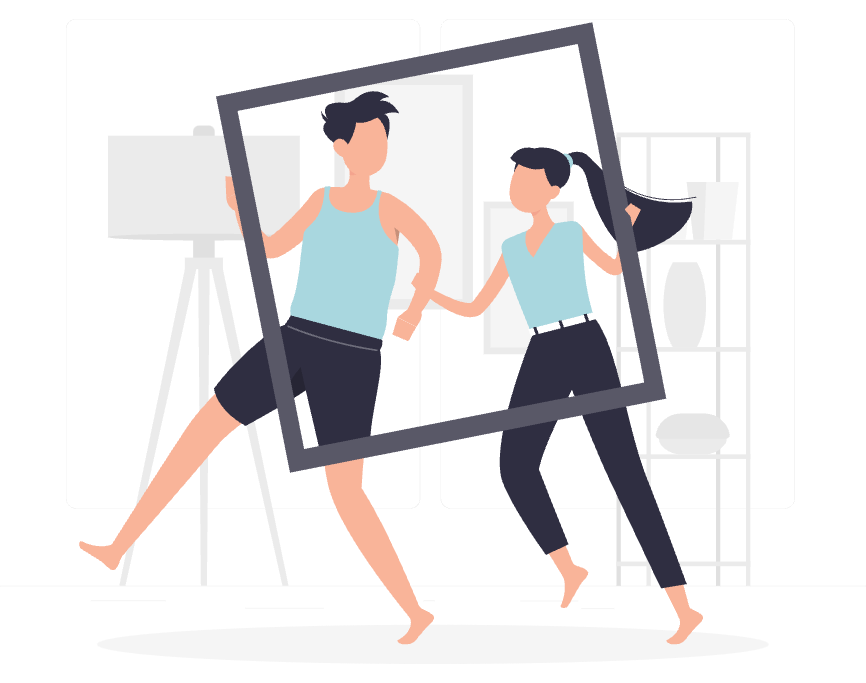I’d like to invite you to explore the power of reframing in improving wellbeing.
When you go to a museum, you will notice that tremendous attention has been devoted to placing artwork within appropriate frames. The frame affects how the piece is seen.
The same is true in our lives.
We see ourselves and our circumstances differently depending upon how we frame them.
Perhaps the best-known of these framing issues is the one about the glass being half-full versus the glass being half-empty. Both interpretations of the glass are equally valid and yet they lead to different emotional responses.
Or think about the “healthcare workers are heroes” movement. I believe (rightly or wrongly) that it started with good intentions. Community members were looking to express appreciation for healthcare professionals in the midst of the pandemic.
But somewhere along the way, the idea got co-opted and corrupted. It was ripped out of the appreciation frame and thrust into a productivity-at-all-costs frame. Suddenly “healthcare workers are heroes” meant that you were not allowed to have needs. To require rest. To feel distress. To fail.
No longer an effort to uplift, it was a tool to beat down. The frame (appreciation versus expectation) made a lot of difference.
Consider also these sayings:
“Caught between a rock and a hard place.”
“Out of the frying pan into the fire.”
These common expressions capture our dilemma when we face nothing but unpleasant options. They also capture the fact that there are options.
We might not like any of them.
But until we acknowledge that we are making a choice, we are giving away our power to change that choice.
Rock or hard place? Frying pan or fire?
You are the one writing your story. And it can be both liberating and distressing to accept that.
One of the ways you can reclaim your agency and reduce your distress is through reframing “have to” to “choose to.”
Instead of thinking (or saying) “I have to go to work tomorrow,” think or say “I choose to go to work tomorrow.” Unless someone is at your house physically dragging you to your job, you *are* choosing to go. And owning that is a good thing.
You may be choosing to go because of money, status, desire to help the team, parental expectations, fear of negative consequences, inertia, habit, passionate commitment, something else, or (most likely) a mixture of a lot of reasons. Recognizing that choice decreases feelings of helplessness – and also gives you the opportunity to evaluate whether the choice is right for you.
None of this excuses bullying, abusive, or toxic workplaces. Changing “have to” to “choose to” is only about your actions and reactions, and acknowledging your power to shape your own decisions despite your circumstances.
Another way to use reframing to your benefit is to put a more positive interpretation on a difficult or negative situation. You don’t want to tell yourself that up is down; positive reframing remains grounded in reality. Sometimes we just have to accept that things are really bad (more on that in a future piece). But often we can find a positive element or an aspect of the situation for which we can be grateful. This must be authentic in order to be effective. And it must be something that you are freely choosing to do for yourself rather than something that someone is trying to foist upon you.
I once had a job in which scheduling errors were so common that they were the norm. It was nothing to have two individual psychotherapy patients with no relationship to each other scheduled in the same therapy hour. Management response was along the lines of “make it work.” And my initial gut reaction was “but I can’t make it work!” Unless you can warp the space-time continuum, you will not be able to provide two hours of therapy in the same one-hour time period.
The situation begged for a reframe. No, I could not warp the space-time continuum. But I could use my therapy skillset to deliver a heartfelt apology and still help patients feel cared-for. I could manage my own emotions in the face of their frustration. I could take the opportunity to get better at identifying the most pressing concerns. And I could be, and am, grateful for the ways in which this scheduling experience shaped my own scheduling procedures when I went into private practice.
These scheduling errors were not a good time. If I had the choice between going through them or not then despite what I learned, I would choose not. But I didn’t have that choice. I did have the choice to try to reframe the situation and to take what positives I could from it.
Over the next couple of weeks, I encourage you to try:
- replacing “have to” with “choose to;” and
- making a conscious effort to identify positive aspects (if any) of distressing situations.
I’d love to hear how your experience goes.

Leave a Reply